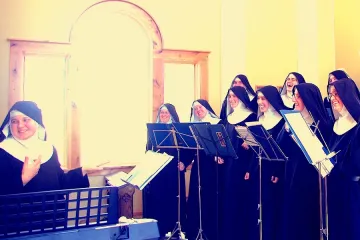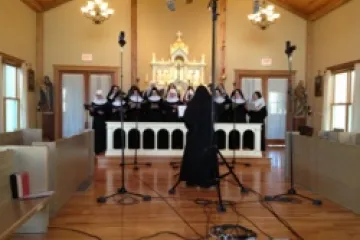Kansas City, Mo., Dec 3, 2021 / 15:06 pm
After the harrowing experience of shootings at their abbey in rural Missouri, the Benedictines of Mary, Queen of Apostles resolved to record an album for Christ the King in thanksgiving for His protection and governance.
“We were talking about a CD dedicated to Christ the King last year, realizing it was a feast we had not yet covered in our recording history. It seems a tumultuous time on so many levels, we thought that focus on Christ as our true leader and Prince of Peace was apt for these days. This was drilled home especially after some unfortunate incidents at the Abbey,” Mother Cecilia, abbess of the community, told CNA.
“In March, we had a series of three shootings at the Abbey, and one of the bullets entered my room, five feet from my bed. The incidents really lit a fire under us to get going on the CD we had discussed, since we realized the power of the protection of Christ and His angels over our Abbey. So the CD is also an act of gratitude to Christ our King and to all the many people who have shown their love and concern for us.”
The generosity of the abbey's benefactors has allowed the closing of the road alongside the property, “and a wall in front of our property was installed for our protection,” Mother Cecilia explained.
“We see in it a symbol of the spiritual protection Christ our King is always giving us, and it was appropriate to hail Him as the 'inexpugnable wall' in the ancient chant of Christ the King, the Laudes Regiae, sung at Charlemagne’s coronation over 1220 years ago.”
Christ the King at Ephesus is the latest offering from the chart-topping community of nuns, who have also released seasonal albums for Advent, Christmas, Lent, and Easter; and in honor of saints and the Eucharist.
The album includes 20 songs, from well-known works such as “the traditional and melodic Christus Vincit, as well as To Jesus Christ our Sovereign King,” to pieces which have significance to the abbey, such as Catherine Maguire’s King of Kings, which Mother Cecilia noted “was sung at the high school graduation of a priest friend of the community.”
“We could not leave off The King of Love My Shepherd Is, nor Palestrina's Jesu Rex Admirabilis, familiar to many through its inclusion in The Sound of Music,” the abbess said.
“Byrd’s Non Nobis was always the starting piece for the Burke family singers. It was the father’s idea, in order to keep the kids humble! Vexilla Christus Inclyta was written for the Office of Christ the King by Fr. Vittorio Genovesi, and it was released by Pius XI the day after his publication of Quas Primas, extending the feast of Christ the King as a universal feast.”
Also included is St. Robert Southwell's The Bonnie Prince. The Jesuit priest and poet's work is set to the music of Auld Lang Syne.
Christ the King at Ephesus is the first album that the nuns have recorded in their new abbey church, which they have now been using for three years.
“We finally got to [record] in this edifice that is not only beautiful, but offers amazing acoustics, which was a real boon for the process - which has been a whirlwind!” Mother Cecilia related.
The album was recorded over two days in September, and was released the following month.
The recording and sound engineering was done by William Crain of BRC Audio in Kansas City, the abbess said. “We did the editing and production, and Will brought it all together along with the mastering.”
Life in the community is marked by obedience, stability, and "continually turning" towards God. They have Mass daily according to the ancient use of the Roman rite, and chant the psalms eight times a day from the 1962 Monastic Office.
(Story continues below)
The nuns also support themselves by producing made-to-order vestments, as well as greeting cards.
Since the abbey's last album release, its church has been built, as has a guest house for families and those wishing to make a silent retreat. The community's foundress, Sr. Mary Wilhelmina, “went to her heavenly reward at 95 years old,” Mother Cecilia added. The abbess said Sr. Wilhelmina's “life and the amazing circumstances of her death” were both “a grace beyond our imaginings.”
The community has been blessed with abundant vocations in recent years, Mother Cecilia said.
A group of eight sisters was sent to found a daughter house in southern Missouri, and “We now number 55 Sisters between the two houses, and young women continue to knock on our door,” she related.
The sisters at the daughter house “are living in a temporary residence, and one which does not lend itself to growth. So the construction of this monastery is imperative, as we have no more room here at the abbey either. We certainly do not want to turn away young women who are called to this life on account of no space!”






